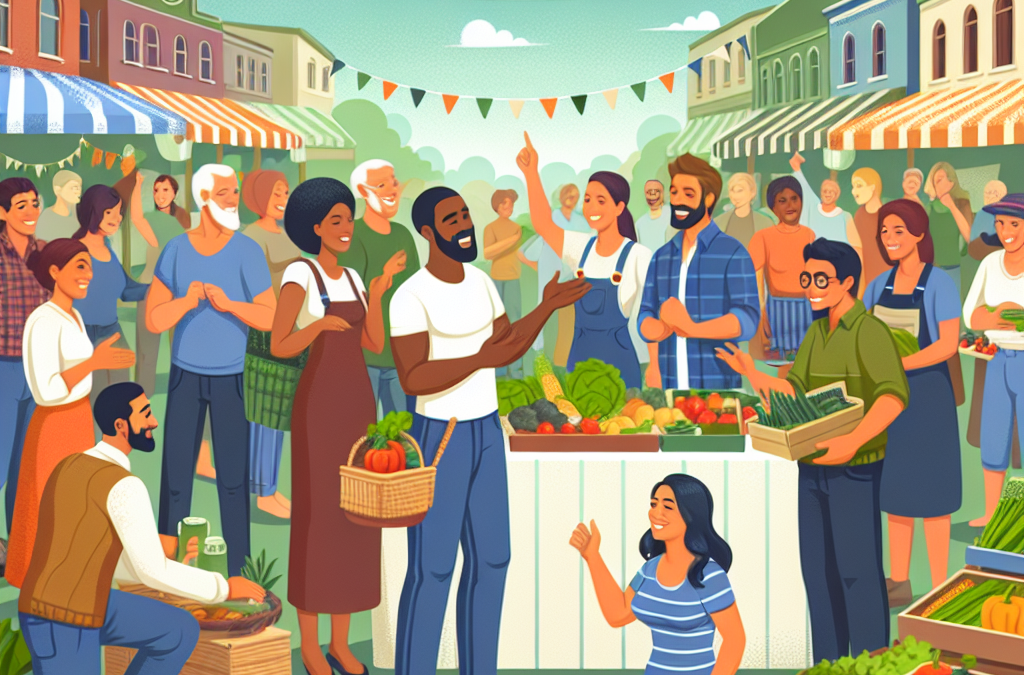Understanding Your Community’s Needs
Engage with Local Residents
Engaging with local residents is hands down one of the most effective ways to understand what your community actually wants and needs. I’ve spent countless hours chatting with folks around town, striking up conversations at coffee shops or local events. It’s amazing how much intel you can gather just by being approachable and friendly.
Through these interactions, I typically take notes on common themes: What do people think about local businesses? What services are they missing? You’ll often find that people are eager to share their thoughts, and this info is gold when laying the groundwork for your marketing strategies.
Additionally, setting up community forums or participating in local groups can deepen your connection with residents. You’ll discover trends and insights that might shape your marketing efforts—trust me, it’s worth the time and investment!
Utilize Surveys and Feedback
Surveys can be a game changer in terms of understanding community needs. I often create simple surveys that can be distributed online or even handed out at community events. It’s great to get direct feedback on what people like or dislike about local services.
Don’t just stop at ‘yes’ or ‘no’ questions—open-ended questions can lead to amazing insights. For example, ask residents what new businesses they’d want to see in the area or what improvements they wish to see in existing ones. These nuggets of information can be the foundation for your marketing efforts.
Once you’ve gathered feedback, make sure to share the results with your community. This not only shows that you value their input but also fosters a deeper sense of connection and trust between you and the local residents.
Research Local Trends
Understanding local trends is about more than just sales data; it’s also about tapping into the cultural heartbeat of your community. I’ve spent time looking into local news, social media trends, and attending community events to see what’s hot and what’s not.
When you’re in touch with what’s trending, you can create marketing strategies that resonate deeply with your community. For instance, if there’s a growing interest in sustainability, you might consider incorporating eco-friendly practices into your business model, and then highlighting that in your local marketing.
Keep in mind, the trends aren’t static—what’s popular today might shift overnight. Therefore, consistently researching and staying informed is key to being an effective local marketer!
Creating Relevant Content
Highlight Community Stories
Sharing stories about local heroes, artists, and businesses can strengthen community connections and draw interest to your business. I make it a point to feature local individuals on social media and in newsletters—I call it “CAPTURING THE COMMUNITY SPIRIT.”
When you spotlight someone’s success or contribution, you not only celebrate them but also showcase your brand as supportive and community-oriented. Plus, people love to share stories about themselves and their favorites, and this creates a natural promotional channel for you!
The authenticity that comes from local storytelling can make your marketing efforts stand out. I find that these posts frequently lead to increased engagement and community interaction, which helps spread the word about my business in a fun, relatable way.
Educational Workshops and Events
Hosting workshops is another great way to create relevant content while giving back to the community. I’ve organized a variety of workshops from DIY crafts to financial literacy, and they’ve been a hit every time!
These events not only educate but also position your business as a resource for the community. Plus, people are typically more willing to check out a business that gives them something useful while providing a platform for community gathering.
Also, showcasing your expertise in a particular area helps to build trust. When folks see you as a knowledgeable figure, they’re more likely to choose your offerings over competitors’. Plus, it’s a blast to get to know people in a fun, informative setting!
Utilizing Local SEO
Local SEO is essential for any business looking to thrive in their community. By optimizing your website for local searches, you make it easier for potential customers to find you when they’re searching online. Trust me, the number of people looking for “best coffee shop in [Your Town]” is staggering!
I recommend focusing on keywords that are specific to your area. This means including your city, neighborhood, and even popular local landmarks in your website copy and meta tags. It’s an effective and often under-utilized strategy that can put you right on the map.
Moreover, keeping your Google My Business account updated with accurate information, responding to reviews, and regularly posting on your blog can significantly enhance your local presence. All these little tweaks can make a huge difference in being discovered by your community!
Building Local Partnerships
Collaborating with Other Businesses
One of the coolest parts of local marketing is collaborating with other businesses. Partnering with a local café for a promotional event or cross-marketing each other’s products can bring in a whole new audience! These collaborative efforts not only increase visibility but also strengthen community ties.
From my experience, brainstorming sessions with other local business owners can lead to some of the best ideas. Think outside the box—maybe a themed market day where different businesses have booths? It’s about creating an experience that benefits everyone involved!
Plus, when you collaborate, you’re tapping into each other’s audiences, offering something fresh, and supporting each other’s growth, which is what community marketing is all about.
Engaging Local Influencers
Another effective strategy I’ve found is working with local influencers. These could be anyone from bloggers to social media personalities within your community. They understand the local vibe and can help promote your business in a more organic way, which people really appreciate.
Start by seeking out those who align with your brand values. I recommend reaching out to them with a fun collaboration idea—perhaps an Instagram takeover or a joint event. The goal is to tap into the audience they’ve built and introduce them to your brand in a natural, engaging way.
Remember, building relationships with these local influencers shouldn’t be transactional; it should be about building a genuine connection that benefits everyone involved! And there’s nothing better than having an influencer who truly loves your brand advocate for you.
Community Initiatives and Support
Supporting local initiatives not only shows that you care but also helps cement your position in the community. Whether it’s sponsoring a youth sports team or participating in a charity event, these acts of generosity speak volumes.
In my experience, getting involved with local initiatives not only boosts your brand awareness but also builds goodwill among residents. People tend to gravitate towards businesses that align with their values and support the things they care about.
Lastly, sharing your community involvement on your marketing platforms can inspire others to join in or create goodwill and loyalty among your existing customers. To me, that’s a win-win!
Measuring Success and Adjusting Strategies
Setting Clear Goals
When venturing into a community-focused marketing strategy, I’ve found that setting clear goals is crucial. What do you want to achieve? Higher foot traffic? More engagement on social media? Whatever it is, having specific objectives helps keep your efforts focused.
Be sure to write down your goals—there’s something about putting pen to paper that makes them feel more tangible! Also, track your progress regularly to see if you’re on the right path or need to pivot a bit.
Trust me, set measurable goals because they serve as benchmarks and help you see what methods are working and what might need tweaking.
Collecting Data
In this digital age, collecting data on your marketing efforts is easier than ever. I keep tabs on social media engagement, website analytics, and customer feedback to gauge how well my strategies are working. Analyzing this data can uncover trends and provide insights into customer behavior.
For example, if certain types of social media posts consistently receive higher engagement, it’s a good idea to create more of that content. Conversely, if something isn’t working, don’t be afraid to adjust your approach. This flexibility is key to effective marketing.
Utilizing customer relationship management tools can also help streamline the process of data collection and analysis. It’s all about making that data work for you, right?
Adjusting Your Approach
Lastly, remember that what works today might not work tomorrow. One of the best pieces of advice I can share is to be willing to adapt your strategies based on what the data tells you. Sometimes it’s a mild tweak, and other times it may require a complete overhaul.
Staying attuned to the evolving needs of your community means being flexible and open to change. This adaptability maximizes your chances for success in local marketing efforts.
Always review your strategies regularly, and don’t be afraid to pivot when necessary. Trust me, your community will appreciate your effort to stay relevant!
FAQs
1. How do I start building a community-focused marketing strategy?
Start by understanding your community’s needs through engagement, surveys, and research. Get a feel for what residents want and what’s currently missing in the marketplace.
2. What type of content should I create for my local marketing?
Focus on content that highlights local stories, provides educational value, and incorporates communities’ interests. Think about events, workshops, or relevant blog posts that will resonate with residents.
3. Why is collaborating with other local businesses important?
Collaboration helps expand your audience, enhances brand visibility, and fosters community spirit. It’s a great way to share customers and support one another!
4. How can I measure the success of my local marketing efforts?
Set clear, measurable goals from the outset and track your progress. Use data analytics to monitor what strategies yield the best results, and be ready to adjust based on those insights.
5. What if my marketing strategies aren’t working?
First, analyze your data to identify areas for improvement. Be open to feedback, and don’t hesitate to pivot your approach if something isn’t resonating with your community.


